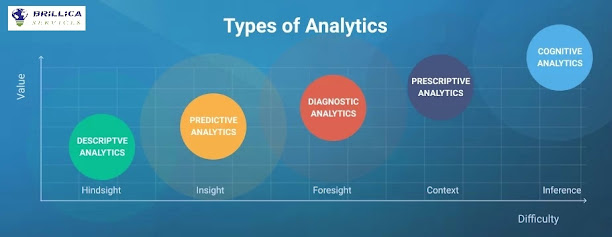Different Types of Analytics
As it is known that there are different types of analytics to process the data, but many businesses don’t know when to hold what. In fact, what differentiate the best data scientist or data analyst from others is their capability to identify the right kind of analytics that best fits the best business needs to maximize the outcomes. Different types of analytics offer perceptible insights.
In this article, we will learn about the five different
types of analytics and their importance in our business.
Understanding the different types of analytics provided,
added value to a business to improve its organization-level operational
capabilities. Choosing the right form of data, analytics can make most of the
unstructured or structured data they own.
Types of analytics to be discussed are:
1. Descriptive Analytics
90% of the organizations around the world uses descriptive
analytics for working on the data. It is the simplest class of analytics that
allows you to compress the big data into smaller units to drive more acute
insights. It is a common tool imposed today to drive important information from
social and detailed media tools and websites. Imposing descriptive analytics
allows businesses to decode the inner context and reasons behind the previous
success or failure.
Descriptive analytics helps in extracting the extreme value
through data mining to build and experience a business intelligence system that
analyses real-time and historical data to extract insights for the future
approach. Examples of descriptive analytics include generating financial or
sales reports.
2. Diagnostic Analytics
Diagnostic analytics
is the second form of data analytics which helps the business in solving the extreme
challenges by answering if something is happening, and why is it happening, and
what is the root cause behind it. Diagnostic analytics plays an important, when
a business with business intelligence dashboards, wants to penetrate inside the
data to find the reasons or factors which affect the business. Combining
diagnostic analytics along with descriptive analytics helps businesses a lot in
finding relations and structure of the data to do a quick comparison to build
the most reliable data-based decision model. The example of diagnostic
analytics consists the HR department analysing the applicant’s data sets.
3. Predictive Analytics
It is always spellbinding to forecast the future, also to
predict the market trends, a change in the customer behaviour, competitors’
analysis to enhance and build futuristic strategies to maximize the business
outcomes. Predictive analytics is all about the foreseeing. Businesses utilize
the insights-driven from descriptive and diagnostic analysis and other
historical data sets available to build a proposal-based model by leveraging
advanced statistical and machine learning models.
For instance, strengthening predictive analytics models in
healthcare industry can identify if a person is liable to a heart attack or not
by analysing its past health records and general demographics. Similarly,
predictive analytics can be strengthened to design a campaign based on the purchase
behaviour of consumers at different points of time in the past.
Examples of predictive analysis includes analysing product
recommendation data sets to predict the likelihood of different outcomes.
4. Prescriptive Analytics
Prescriptive analytics is the next step after predictive
analytics which helps businesses in creating prescriptions to solve the
business problems based on the derived factors from the data. Big data is a
lack box, and it is always uncertain to predict the most reliable inputs, but
it also always highlights why those problems occurred. And it is where
prescriptive analytics comes into play. Prescriptive analytics advices
businesses on all possible outcomes and results in actions that are more likely
to maximize the business outputs. Prescriptive analytics can also be defined as
a business escalation data analytics process which provides insights on “what
should a business do” to solve a problem. This technique allows businesses to
make informed decisions during uncertain times.
Examples of prescriptive analytics include marketing and
business cycle reports.
5. Cognitive Analytics
Cognitive analytics is the most advanced form of analytics which
combines a number of intelligent technologies like artificial intelligence,
machine learning algorithms, deep learning models, and more to processes the
information and to draw inferences from existing data and patterns, to derive
conclusions. These findings are further added to the knowledge base for future
involvements, and the self-learning feedback loop mirror human thinking to make
cognitive applications smarter and effective over time.
Examples of cognitive analytics include processing vast
parallel/undistributed data (such as call center conversation logs) computing
to derive insights.
These are different types of analytics and we hope you
understood their importance for your business to boost your growth and increase
your market presence.
Data
analytics may be a process of inspecting, cleansing, transforming, and
modelling data with the goal of discovering useful information, informing
conclusions and supporting decision-making.
Data
analytics has multiple facets and approaches, encompassing diverse
techniques under a spread of names, and is employed in several business,
science, and science domains. In today's business world, data
analytics plays an important role in making decisions more scientific and
helping businesses operate more effectively. Nowadays, the info analytics
masters programming course is that the latest and trending language within
the corporate area. Brillica
Services provide the simplest knowledge about Data
analytics masters training in Dehradun. Data Analytics certification is
that the hottest and powerful programming language used nearly altogether Data
analytics courses in Dehradun Uttarakhand, Data Analytics certification and
operations.
Follow for more: https://www.brillicaservices.com/


Comments
Post a Comment